Text
Learn Korean with Korean Children’s Shows
Many children’s media is easily accessible too, with a lot of shows officially uploaded to YouTube for free so you don’t have to hunt down resources or pay for a specific subscription or platform. They are great for beginner practice because of the easy-to-follow plots, simple dialogue, and story!

Hello Jadoo – 안녕자두야
The plot focuses on a young girl in Seoul and her antics with friends and family.
The Youtube channel Learn Korean with Jadoo is a good resource, with both Korean and English subtitles (with subtitle options for more languages too!) in short 10min episodes.
Pororo the Little Penguin – 뽀롱뽀롱 뽀로로
The most popular recent Korean children’s TV show, Pororo has hour-long episodes uploaded to YouTube for free as well; but the official channel doesn’t come with English or Korean subs so keep that in mind.
Dooly the Little Dinosaur – 아기공룡 둘리
A late 80s to 90s Korean kids’ TV show, Dooly is also an official South Korean citizen
Anpanman – 안판만
Popular children’s show about a bread superhero, it’s Japanese but still big in Korea (and dubbed in Korean), also referenced in the iconic BTS song
Pinkfong 핑크퐁
No doubt you probably know “Baby Shark”, which craze was started by the Pinkfong channel originally in Korean and then into English. They have a bunch of Korean songs and short stories on their channel.
JunyTony 주니토니
Channel about animated twin wizards with animal friends, who go on magical and musical adventures, using their spells to save the day.
yearimTV 예림TV
This YouTube channel has many short stories and songs like the others, but also has a focus on traditional Korean stories.
#korean#korean langblr#korean studyblr#korean culture#culture#korean resources#resources#tv shows#studyblr#langblr#mine
20 notes
·
View notes
Text
Korean Onomatopoeia!
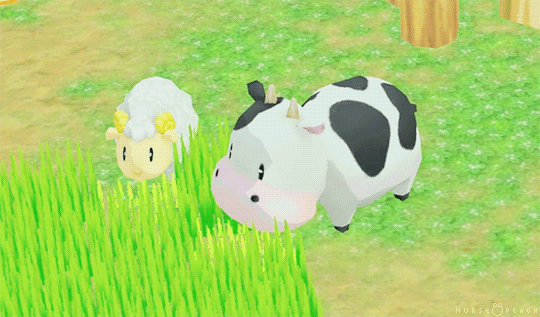
Animal Sounds In Korean
멍멍: barking (dog sound)
꿀꿀: oink (pig sound)
야옹: meow (cat sound)
음매: moo (cow sound)
매애: baa (sheep sound)
찍찍: mouse’s squeak
훨훨: flutter flutter (butterfly/bird flying sound)
윙윙: buzzing (bee/fly/flying insect sound)
짹짹: chirp/tweet (bird sound)
까악: crow’s caw
꽥꽥: quack (duck sound)
꽤액: goose’s honk
개굴: ribbit/croak (frog sound)

Water
쏴: rain pouring down쏴쏴: the sound of spraying water
주르륵: the sound of water dripping
철벅철벅: splash
주르르: trickle
부글부글: bubbling/boiling
어푸어푸: spitting water out of your mouth
풍덩: splash when jumping into water
철썩: splashing back and forth

Sound Effect Onomatopoeia
쾅: bang
쿵: heavy thud
쾅: crash
칙칙폭폭: chugga chugga choo choo (train sound)
똑똑: knock knock
반짝반짝: sparkle/twinkle
펑: poof
싱: zoom
따르릉 따르릉: ring ring
부릉부릉: car engine vroom vroom
모락모락: smoke/steam
우르릉: rumble of thunder

Action Onomatopoeia
킁킁: sniff
에취: achoo
콜록콜록: cough cough
켁켁: choking
앗: oops
음: ummm…
또릿: ahem!
깍꿍: peekaboo
흑흑 / 훌쩍훌쩍: crying
왈칵: sobbing
울망: tearing up/about to cry at any moment
메롱: sticking your tongue out
뽀뽀: kiss/smooch
얌냠: om nom nom
두근두근: heartbeat
우웩: vomiting bleeh
응애응애: baby crying
보들보들: soft/cuddly
뒤 뚱뒤뚱: waddle
#korean#korean langblr#korean studyblr#korean onomatopoeia#studyblr#vocab#langblr#onomatopoeia#video game gifs this time hehe#mine
13 notes
·
View notes
Text
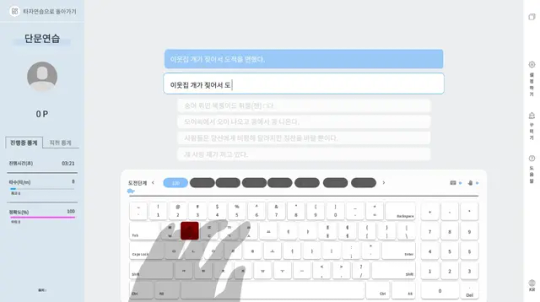
Hancom Typing Game
This site is in Korean but has the option for English in the top right corner. The site offers options for learning the proper typing form and going through the keys, typing out certain words, and typing out sentences as well. In the virtual keyboard it will tell you where the key is and show proper hand position as well, and just above will measure your speed.
I think this site works out well because there are different options to pick from; so if you’re a beginner just starting out you can focus on just learning the keys, then move on to words, and then full sentences. There’s opportunity for every skill level and benefits even people just wanting to improve their typing speed or form.
There’s also a leaderboard for people that like a bit of competition. There’s individual ones for each option, words, sentences, and stories so you can use that to fuel your drive to master typing!
#korean#korean langblr#korean studyblr#mine#studyblr#korean grammar#langblr#korean resources#resource
113 notes
·
View notes
Text
Happy 추석/Chuseok!
추석 also known as 한가위, is Koreas autumn harvest festival, similar to thanksgiving or other such celebrations. It's celebrated in both North and South Korea and lands on the 15/8 on the lunar calendar so it changes each year, but for this year it starts on September 28 and goes on until the 30th. Uniquely 추석 guarantees 3 days off; the day before, 추석 day, and day after.

Where Does Chuseok Come From?
Chuseok is an age old celebration so when it originated is a bit debated. Some think it comes from around 57 BC - 935 AD as a part of another celebration called gabae. Gabae was a month-long weaving contest between two teams and when the competition was over the winner would be treated to a feast from the losing team.
Other think that it is tied to celebrations for the harvest moon where people would offer deities and ancestors new harvests. Which means chuseok could have started off as a worship ritual.
Whichever the origins or history, 추석 has developed to be a big family event in Korea, with a lot of specific foods and events going on. The event celebrates family, food, and the large harvest before winter starts to come in.
Some common holiday foods are:
Yakgwa 약과
Jeon 전
Saengseon Twigim 생선튀
Hangwa 한과
Songpyeon 송편
Before there was more of a culture to make 송편 with family and go all out; doughs would be died naturally and made into unique shapes. There was even a common saying that said: “송편을 잘 빚으면 예쁜 딸을 낳는다” or in English: “If you shape 송편 well, you’ll have a pretty daughter”.
What are the traditions of Chuseok?
Visiting with Offerings Ancestors Graves:
추석 is all about family, both alive and past. Koreans usually hold a memorial service, or charye (차례), in honor of their ancestors and offer certain foods to them such as rice and fruits. Which additional food is offered changes a bit depending on region though, in Seoul salted fish and meat dishes are offered along with rice for instance.
When giving appreciation to ancestors Koreans also go to the family grave plot and sweep and clean the area. Then, they bow to their ancestors graves as a whole family which is called sungmyo (성묘).
Giving Gifts on Chuseok
People also need to celebrate their live family! 추석 gift sets are common to find around in Korea before the holiday begins in stores and supermarkets. Many gifts are very food and health focused; from having fruit, alcohol, and meat, to ginseng products, health products, and others.
Interestingly though; the fruit gifts are pretty pricey and filled with premium fresh fruits. So don't mistake them for the fruits you normally get at the grocery store. Quality Beef is also an expensive gift to give that people really love.
12 notes
·
View notes
Text
And in Korean
그리고
그리고 can be used at the beginning of a sentence or to conjoin two things together:
어제는 제가 옷을 샀어요. 그리고 공원에 갔었어요: Yesterday I bought clothes. And I went to the park
언니가 고양이 그리고 개 있어요: My older sister has a cat and dog
저는 영어 그리고 한국어 해요: I speak English and Korean
~하고
하고 is just used when linking nouns together:
오빠가 고양이하고 개 있어요: My older brother has a cat and dog
저는 영어하고 한국어 해요: I speak English and Korean
~고
~고 it is used to link verbs and adjectives like this:
어제는 제가 옷을 샀고 운동했어요: I bought shoes and exercised yesterday
저는 밥을 먹고 갈 거예요: I’ll eat and go
울고 싶지 않아: I don’t want to cry
~과 / 와
과 / 와 are both used for linking nouns.
~와 nouns ending with a vowel
~과 nouns ending with a consonant
나는 친구와 갔어요: I went with my friend
저는 선생님과 함께 공부했어요: I studied with my teacher
~(이)랑
Used with nouns, more spoken than written, less formal
저는 사과랑 바나나를 먹어요: I eat apples and bananas
With in Korean
If there are nouns the above particles have to be used but if there are none then 같이 and 함께 becomes like ‘together’
같이 most common
함께 more formal
우리는 함께 먹었어요: We ate together
저는 친구 랑같이 갔어요: I went with my friend

21 notes
·
View notes
Text
Batchim rules
There are 7 key batchim rules that depend on the consonants used. Some characters like ㄱ, ㅋ, and ㄲ share the same rule as you can guess because they are very similar consonants.
ㅇ = ㅇ
ㄱ, ㅋ, ㄲ, ㄳ, ㄺ = ㄱ
ㄷ, ㅌ, ㅅ, ㅆ, ㅈ, ㅊ, ㅎ = ㄷ
ㅁ, ㄻ = ㅁ
ㅂ, ㅍ, ㅄ, ㄿ = ㅂ
ㄹ, ㄼ, ㄾ, ㅀ = ㄹ
ㄴ, ㄵ, ㄶ = ㄴ

I’ll lay it out like this:
WORD –> PRONOUNCIATION : ROMANIZED
1. Rules for ㅇ
Starting off with ㅇ because it’s important to batchim rules overall. Once you learn how to read hangul you learn ㅇ is either an empty space when used first (like 아니) or an ‘ng’ sound at the very end (like 사랑).
The ‘ng’ sound is the ㅇ characters batchim, it never changes. BUT there’s more- if ㅇ begins the next syllable in a word the batchim will change:
있어 –> 이써 : isseo
있다 –> 읻다 : et-da
For the first one the bottom consonant ㅆ takes over the space of ㅇ for pronunciation making it sound more like 이써. 있다 above follows the normal batchim rules and the ㅆ takes on a ㄷ sound.
2. ㄱ, ㅋ, ㄲ, ㄳ, ㄺ = ㄱ
This rule affects consonants including ㄱ or his relatives and simply makes anything a ㄱ sound no matter how hard the character would be on its own. Even ㄳ which is combo k and s becomes just k sound.
한국어 –> 한구거 : hangugeo
책은 –> 채근 : chekgun
3. ㄷ, ㅌ, ㅅ, ㅆ, ㅈ, ㅊ, ㅎ = ㄷ
This affects a bunch of consonants so it’s important to remember.
꽃 –> 꼳 : ggot
좋다 –> 조타 : jota
There’s a special rule about ㄷ and ㅌ ending before a ㅇ though. You’ve probably heard it with 같이; instead of becoming 가티 the ㅌ changes to ㅊ making it 가치. ㄷ changes to ㅈ as well.
같이 –> 가치: kachi
4. ㅁ, ㄻ = ㅁ
몸이 –> 모미 : momi
5. ㅂ, ㅍ, ㅄ, ㄿ = ㅂ
없다 –> 업따 : ob-da
없어요 –> 업서요 : ob-seoyo
Now ㅂ has some special rules for itself, you probably knows 감사합니다 but it’s not pronounced kamsahaBnida it’s more like kamsamnida
ㅂ starting a word – use a softer b sound: 바나나
ㅂ in the middle – it creates a b sound: 일번
ㅂ at the bottom – can have m sound depending on what follows like in 감사합니다
A trick to think of is try saying 감사합니다 20x fast. Maybe originally the word was pronounced fully but people get lazy, slur their words, etc and pronunciation goes towards what’s easiest.
6. ㄹ, ㄼ, ㄾ, ㅀ = ㄹ
별이 –> 벼리 : byeo-re
핥은 –> 할튼 : halteun
7. ㄴ, ㄵ, ㄶ = ㄴ
앉다 –> 안다: anta
돈이 –> 도니 : doni
#korean#langblr#studyblr#korean studyblr#korean langblr#batchim#hopefully this is easy enough to digest haha#grammar#mine#korean grammar
147 notes
·
View notes
Text
Korean Age; Why is Every Korean Younger Now?

Out with the old in with the young! Korean age has been removed this week and replaced with “international age” or the regular birthday age other countries typically use. For a while now many Koreans and politicians have wanted to put an end to the Korean age system. A recent 2022 survey suggested “86% of South Koreans said they would adopt the international system”. So better late than never the change starts now!
What is/was Korean Age?
Korean age basically adds a year to the age you are/will be this year to put it simply. Let’s run through the example of being born in 2000: this year you will/have turned 23, between friends born in the same year no matter what at the end of the year you would have all been 23 right? Koreans add 1 year to this age, ignoring your actual birth date.
Ex:
Born Sept 1 2000: Current age 22, in Korea 24
Born Feb 20 2000: Current age 23, Same age at 24
That’s why you’ll hear that Korean age adds 1/2 years to your age. Instead of following your birthday Koreans look at your birth year – thus adding a year for everyone on the new year as well. Now it’s not like Koreans ignore a birthdate, people will still celebrate with friends and family but this is just how the age system worked.
How This Will Affect People
Obviously a culture won’t switch just overnight. There will still be people using their Korean age for some time in casual conversation for a while as people adapt to using their “international age” permanently.
The government has also changed the drinking age to 19 and news is that age-restricted things will focus on your birth year rather than date. The same goes for inscription laws, people will be eligible based on their birth year- rather than specific birthdate. So for any Koreans born in 2004 whether born in Jan or November you will be able to buy alcohol just the same as last month when you were 20 hah
8 notes
·
View notes
Text
Want to add I was a bit wrong here; for clarity there are actually two different Hanja that are pronounced 교 and both used for educational terms:
校: more specific to the school and environment
敎: related to the education process
校 Hanja: school vocab
학교: school
교문: a school gate
교복: school uniform
교장: headmaster
교정: campus
대학교: college/university
전문대학교: community college
고교: high school (abbreviation of 고등학교)
중학교: junior high school
초등학교: elementary school
敎 Hanja: education vocab
교사: teacher
교수: professor
교직: teaching profession
교실: classroom
교육: education
This is the character used for some religious vocab
교회: church
교훈: moral lesson
기독교: Christianity
불교: Buddhism
유교: Confucianism
종교: religion, a faith
종교적: religious, spiritual
Sino Korean; The 교 in 학교
If you’ve learned some words associated with school or education you might have noticed the reoccuring 교 theme, thats because school terms use sino korean and 교 comes from 敎 which means teach, instruct, give lessons. Heres some education terms it pops up in~
학교 school
교장 principal
교감 assistant principal
교사 teacher (name of profession, you call a teacher 선생님)
보조 교사 teacher’s aide
교탁 teacher’s desk
상담 교사 counselor
교실 classroom
교과서 textbook
교재 teaching materials
교정 proofreading, correction
초등학교 elementary school
중학교 middle/junior high school
고등학교 high school
전문대학교 community collage
대학교 university/college
교육 education, training
교관 drill instructor

bonus info the same 교 from 敎 also shows up in religious words too
종교 religion
교회 church
교황 the pope
교도 believer, follower
교리 doctrine, dogma
기독교 christianity
힌두교 hinduism
유대교 judaism
불교 buddhism
#still not tooooo important if you dont care about hanja#but dont want to misguide anyone#plus added in some extra vocab for everyone#vocab#mine
80 notes
·
View notes
Text
Happy Pride! Let’s look at some Korean LGBT+ Terms

엘지비티: LGBT
레즈비언: Lesbian
게이: Gay
양성애: Bisexual
트랜스젠더 (or 트렌스): Transgender
퀴어: Queer
인터섹스: Intersex
무성애자: Asexual
퀘스처닝: Questioning
범성애자: Pansexual
얼라이: Ally
바이젠더: Bigender
에이젠더: Agender
논바이너리: Nonbinary
이성애: Straight
트랜스여성: Trans woman
트랜스남성: Trans man
씨스젠더: Cisgender
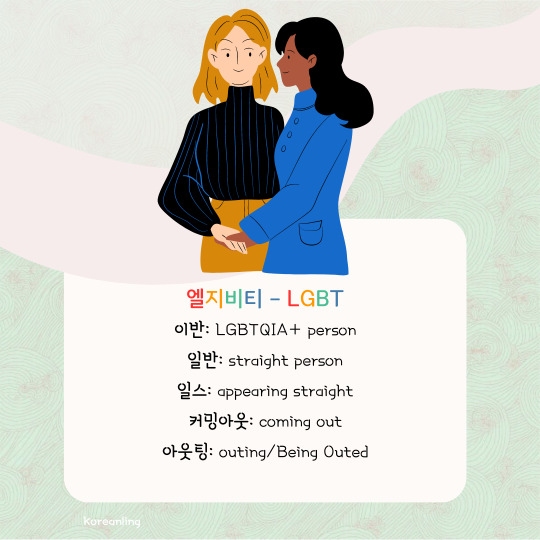
Some Quick LGBT Slang
이반: LGBTQIA+ person (이반인 “abnormal people” – note: not derogatory lgbt claimed this themselves)
일반: straight person (일반인 “normal people”)
일스: appearing straight (short for “일반 스타일 “normal style”)
커밍아웃: coming out
아웃팅: outing/being outed – someone exposes you and forces you out
78 notes
·
View notes
Text
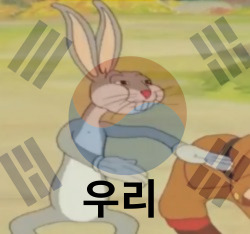
우리 to mean my
koreans like using 우리 to show a sense of community, but not always between them and the speaker. In english when you say ‘I went to our house’ it typically means 1 of 2 things; you and the listener live together or the person you live with is next to you included in the conversation. korean includes another option where nobody living with you is there; nobody even needs to live with you!
우리 is such a part of Korean that sometimes instead of saying 대한민국 or 한국 people will say 우리나라 instead! This is much more casual way to say Korea as compared to 대한민국 or 한국 so not every situation calls for it though.
note: people don’t use 우리나라 to refer to any country, it’s only Korea- so even if both you and your friend were born and raised German 우리나라 still means Korea. but with a space it changes-
우리나라: just korea
우리 나라: 2 separate words, now it means our country and so can be any country
that space is holding a lot of weight huh? idk if i would use 우리 나라 like that though, seems like it could get confusing especially in speech when theres no heard difference at all
anyway here are some examples of koreans use of 우리
family:
mom: 우리 엄마
dad: 우리 아빠
siblings: 우리 오빠, 누나, etc.
husband/wife: 우리 아내/남편
boyfriend/girlfriend: 우리 남친/여친
house: 우리 집
(even if you live alone people still use 우리 집, and while a romantic partner like boyfriend or wife is typically not shared people still use 우리 too.)
work community:
company: 우리 회사
coworker: 우리 회사 동료
company president: 우리 사장님
Its even used with friends, though this is used more dotingly and cutely. And used more with speaking with a shared friend, so talking to someone about your mutual friend Hyunsoo you can say 우리 현수.
18 notes
·
View notes
Text
우리 to mean my
koreans like using 우리 to show a sense of community, but not always between them and the speaker. In english when you say 'I went to our house' it typically means 1 of 2 things; you and the listener live together or the person you live with is next to you included in the conversation. korean includes another option where nobody living with you is there; nobody even needs to live with you!
우리 is such a part of Korean that sometimes instead of saying 대한민국 or 한국 people will say 우리나라 instead! This is much more casual way to say Korea as compared to 대한민국 or 한국 so not every situation calls for it though.
note: people don't use 우리나라 to refer to any country, it's only Korea- so even if both you and your friend were born and raised German 우리나라 still means Korea. but with a space it changes-
우리나라: just korea
우리 나라: 2 separate words, now it means our country and so can be any country
that space is holding a lot of weight huh? idk if i would use 우리 나라 like that though, seems like it could get confusing especially in speech when theres no heard difference at all
anyway here are some examples of koreans use of 우리
family:
mom: 우리 엄마
dad: 우리 아빠
siblings: 우리 오빠, 누나, etc.
husband/wife: 우리 아내/남편
boyfriend/girlfriend: 우리 남친/여친
house: 우리 집
(even if you live alone people still use 우리 집, and while a romantic partner like boyfriend or wife is typically not shared people still use 우리 too.)
work community:
company: 우리 회사
coworker: 우리 회사 동료
company president: 우리 사장님
Its even used with friends, though this is used more dotingly and cutely. And used more with speaking with a shared friend, so talking to someone about your mutual friend Hyunsoo you can say 우리 현수.
18 notes
·
View notes
Photo

꽃 - flower
향기 - scent/aroma
꽃향기 - flowers scent
만 - only
남기고 - left
가(다) - go/leave
갔단다 - past tense of 가다, so left/went
꽃향기만 남기고 갔단다 - only a flowers scent was left
16 notes
·
View notes
Photo
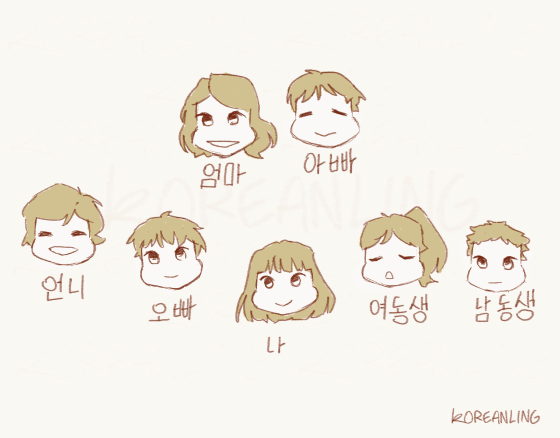
엄마: Mom
아빠: Dad
남매: Sibling(s)
오빠: Older brother (for females)
남동생: Younger brother (any gender)
언니: Older sister (for females)
여동생: Younger sister (any gender)
11 notes
·
View notes
Photo

update on my formalities post from long ago with nice art to help you visualize it more~
i wrote in-depth with a breakdown of each age range to really get into it over here with each person separated out but for now here's the quick easy version!
Quick Breakdown of Korean Formalities
존댓말
polite formal
하십시오체
used with people older/above you hierarchically
especially used with clients, business partners, customers, etc. – people to show respect to
used by news broadcasts and reporters
~ㅂ니다
ex; 합니다, 하십니다
polite informal 해요체
most common and safest speech to use; when you don’t know the person/your relationship
tv show hosts use it
more common with younger generations
~아요/여요/어요
ex; 해요, 하세요
반말
impolite formal 해라체
sort of plain text used in magazines, books, newspapers, songs, etc.
~다/ㄴ다/는다
ex; 한다, 하신다
impolite informal 해체
used with friends, family, people of lower status, or younger than you
ex; 해, 하셔
#korean#studyblr#korean studyblr#korean langblr#langblr#korean culture#culture#mine#i started my own site omggg#i wanna get back into korean langblr and researching and everything i had a great time doing it before#so i have a couple things up there rn#honestly i stopped becaus my job at the time was writing bullshit seo blogs and i rrly didnt want to home from writing to write more#but im outta thereee so i feel much better hah
57 notes
·
View notes
Text

Recently I’ve been using this app called slowly and its pretty useful for language exchange I would really recommend it! Slowly lets you connect with people worldwide with their main feature being that its just like a letter, so based on you and your partners location it will calculate how long the message will take to send, letting you take your time to answer and feel no pressure! though since its like a letter its all text so be aware of that- if you want to focus more of speech and hearing then this doesnt work so well
Everyone lists their interests so its easy to connect and start a conversation. Practicing will be less of a task if youre talking about something you already enjoy. maybe youd like to learn more specific vocab like film related vocab, using the filtered results you can find a partner that also likes movies and chat away~

You can also rate your language ability from interested to fully fluent so everyone can accomidate to each others levels. Heres an example of someones profile; showing how responsive someone is, their interests with ones in common higlighted, and language levels.
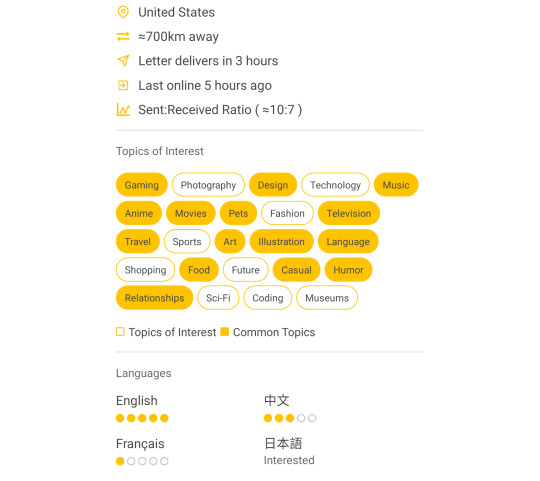
278 notes
·
View notes
Text
Korean Christmas Vocab
Happy Holidays! Christmas in korea is different than western countries, its much more focused on couples almost to the level of valentines day! 추석 and 설날 are already big family events so there was no room for christmas to also be a huge family event

크리스마스 이브 - christmas eve
크리스마스 - christmas
산타 클로스 - santa claus
산타 할아버지 - another name for santa claus
눈 - snow
눈송이 - snowflake
눈덩이 - snowball
눈사람 - snowman
선물 - gift/present
포장지 - wrapping paper
사탕 - candy
초콜릿 - chocolate
케이크 - cake
과자 - confectionery sweet/pastry
과자집 - gingerbread house
사탕 지팡이 - candy cane
별 - star
굴뚝 - chimney
장난감 - toy
벽난로 - fireplace
핫초코 - hot chocolate
북극 - north pole
순록 - reindeer
루돌프 - rudolph the red nosed reindeer
화환 - wreath
겨우살이 - mistletoe
천사 - angel
요정 - elf/fairy
종 - bell
241 notes
·
View notes
Text
Korean idioms
눈이 높다
Lit. eyes are high
Having high standards or unrealistic expectations
눈이 뒤집히다
Lit. eyes turned upside down
To be insane or mad, someone who reached their breaking point and snapped
파리를 날리다
Lit. have flies flying around
Similar to referencing a tumble weed in english. To be in a slump, and for businesses to have no customers, it’s so empty the only customers you have are flies
원숭이도 나무에서 떨어진다
Lit. even monkeys fall from trees
Even an expert can fail and make mistakes
개천에서 용 난다
Lit. a dragon rises up from a small stream.
From rags to riches. Many korean myths say dragons can rise from the ocean so rising from a stream is seen as unexpected and amazing

213 notes
·
View notes